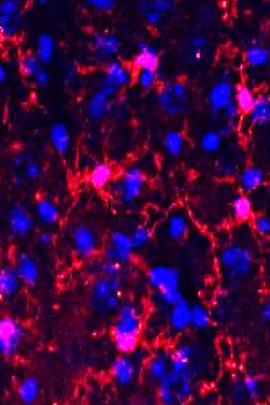
Planning a trip to Mars? You’ll want to remember your anti-radiation pills.
NASA and private space companies like SpaceX plan to send humans to the red planet within the next 15 years — but among the major challenges facing future crewed space missions is how to protect astronauts from the dangerous cosmic radiation of deep space.
Now the lab of UCSF neuroscientist Susanna Rosi, PhD, has identified the first potential treatment for the brain damage caused by exposure to cosmic rays — a drug that prevents memory impairment in mice exposed to simulated space radiation. The study was published May 18, 2018 in Scientific Reports.
Humans venturing beyond the Earth’s protective magnetic fields will be exposed to levels of cosmic radiation estimated to be 1000 times higher than what we experience on earth or even in the International Space Station’s low-earth orbit. Protecting astronauts from this harmful radiation will be key to making deep space exploration — and perhaps one day colonization — possible.
Rosi, who is Director of Neurocognitive Research in the UCSF Brain and Spinal Injury Center and a professor in the departments of Physical Therapy and Rehabilitation Science and of Neurological Surgery, has conducted NASA-funded research for the past four years to understand how deep space radiation may affect astronauts’ brains.
Rosi’s team has previously found that exposing mice to simulated space radiation causes problems with memory, social interactions, and anxiety, and has linked these symptoms of radiation exposure to activation of cells called microglia — part of the brain’s immune system. Activated microglia drive brain inflammation similar to what is seen in neurodegenerative disorders such as Alzheimer’s disease, and also seek out and consume synapses, the information-bearing connections between brain cells.
“We are starting to have evidence that exposure to deep space radiation might affect brain function over the long term, but as far as I know, no one had explored any possible countermeasures that might protect astronauts’ brains against this level of radiation exposure,” said Rosi, who is a member of the Weill Institute for Neuroscience, the Kavli Institute of Fundamental Neuroscience, and the UCSF Helen Diller Family Comprehensive Cancer Center.
In the new study, the researchers collaborated with co-authors at Loma Linda University in Southern California to expose mice for a day to a dose of radiation comparable to what they might experience in deep space. The experiments were conducted at the NASA Space Radiation Laboratory at Brookhaven National Laboratory in New York, the only facility in the country where such experiments are possible. A week later, after being shipped back to UCSF, some of the mice were treated for 15 days with PLX5622, a drug produced by Berkeley-based pharmaceutical company Plexxikon, Inc, and which the Rosi lab had previously shown to prevent cognitive deficits in a mouse model of cancer radiation therapy when administered prior to irradiation of the brain.
In the present study, the irradiated animals initially displayed no cognitive deficits, but after three months they began showing signs of memory impairment. Normally, when researchers place mice in a room with a familiar and an unfamiliar object, the animals spend more time exploring the new object. But mice that had been exposed to space radiation three months earlier explored the two objects equally — presumably because they didn’t remember having seen one of the objects just the day before.

Remarkably, animals that had been treated with PLX5622 soon after being exposed to radiation performed just like healthy mice on the memory task. The researchers examined the animals’ brains and showed that while the brains of untreated mice were full of activated microglia and had lost significant numbers of synapses, the brains of treated mice looked just like normal. The authors hypothesize that by forcing the brain to replace irritable, radiation-exposed microglia with new, healthy microglia, the drug had allowed the animals avoid the cognitive consequences of radiation.
“This is really neat evidence, first that rebooting the brain’s microglia can protect cognitive function following radiation exposure, and second that we don’t necessarily need to treat immediately following the radiation exposure for the drug to be effective,” Rosi said.
Similar compounds to PLX5622 produced by Plexxikon (inhibitors of a cellular receptor molecule called CSF1R) are already in clinical trials for multiple forms of human cancer, which suggests that the new findings could soon be translated to human use, the researchers say. Beyond spaceflight, these compounds could potentially be used to prevent cognitive impairments following cancer radiation therapy, or in age-related cognitive impairment — which has also been linked to microglia-driven brain inflammation.
“NASA is very interested in findings ways of ensuring both astronaut safety and mission success during deep space travel,” said study co-lead author Karen Krukowski, PhD, a postdoctoral researcher in Rosi’s lab. “But astronauts are a small population — it’s exciting that these findings could potentially help prevent many other forms of cognitive impairment.”
Learn more: Deep Space Radiation Treatment Reboots Brain’s Immune System
The Latest on: Space radiation
[google_news title=”” keyword=”space radiation” num_posts=”10″ blurb_length=”0″ show_thumb=”left”]
via Google News
The Latest on: Space radiation
- Space photo of the week: Little Dumbbell Nebula throws a wild party for Hubble telescope's 34th anniversaryon April 28, 2024 at 3:00 am
Astronomers celebrated the Hubble Space Telescope's 34th anniversary with this stunning image of the Little Dumbbell Nebula — a vast cloud of gas containing one of the hottest white dwarf stars ever ...
- Living In Space Won't Be Easyon April 25, 2024 at 9:00 am
It's not a matter of whether humans will live in space - it's a matter of when. The United States is serious about developing an outpost on the moon. The post Living In Space Won’t Be Easy appeared ...
- See incredible time lapses of two of space’s most famous objectson April 24, 2024 at 3:07 pm
Two striking time lapses from NASA's Chandra X-ray Observatory show how two famous objects have changed over the last two decades.
- Streaming and texting on the Moon: Nokia and NASA are taking 4G into spaceon April 24, 2024 at 4:27 am
A mission launching this year will carry a simple 4G network to the Moon, helping to lay the building blocks for long-term human presence on other planets.
- Pentagon research chief calls for commercial radiation-hardened electronicson April 10, 2024 at 3:11 pm
COLORADO SPRINGS — Heidi Shyu, undersecretary of defense for research and engineering, is calling on commercial industry to develop affordable, radiation-hardened electronics. “Commercial innovation ...
- NASA breaks down eclipse radiation mythson April 8, 2024 at 10:45 am
The space agency says that when the moon covers the sun, the corona emits electromagnetic radiation. "Being a million times fainter than the light from the sun itself, there is nothing in the ...
- Space: Radiation-Proof Telstaron February 17, 2024 at 1:52 am
From high in space, the satellite sentthe pattern back ... to avoid damage by the high-speed electronsof the Van Allen radiation belts, which silenced its predecessor afterseven months of service.
- space radiationon October 8, 2021 at 5:00 pm
Earth’s magnetic field acts as a protective barrier against the majority of these cosmic rays, and there is a measurable increase in radiation as you gain altitude and enter space. In space ...
- Space Is Radioactive: Dealing With Cosmic Rayson December 8, 2020 at 2:25 am
and he correctly concluded that there must be some source of radiation penetrating the atmosphere from outer space. The cosmic rays that rain down on Earth are predominantly protons (~90%), helium ...
via Bing News









